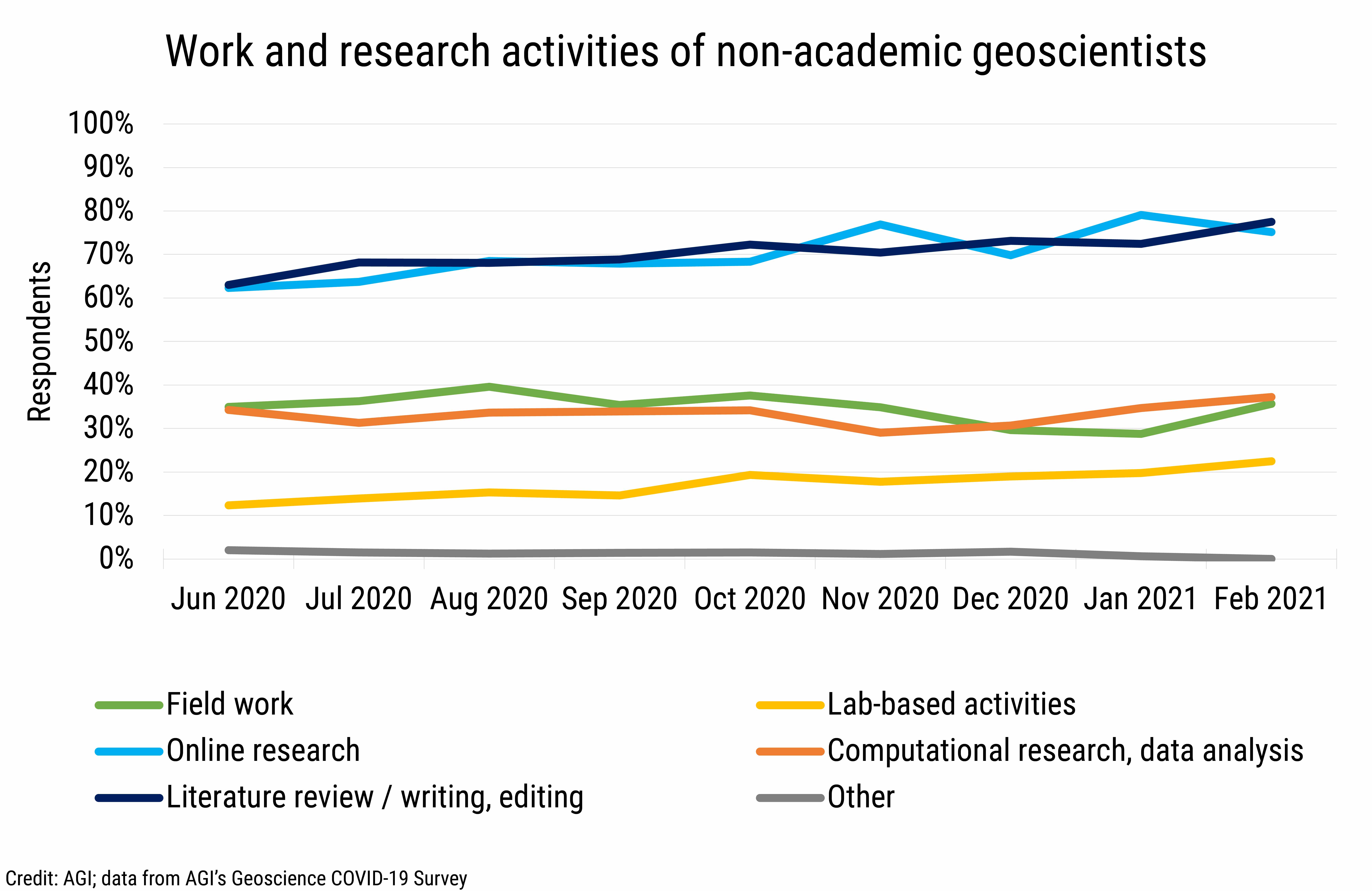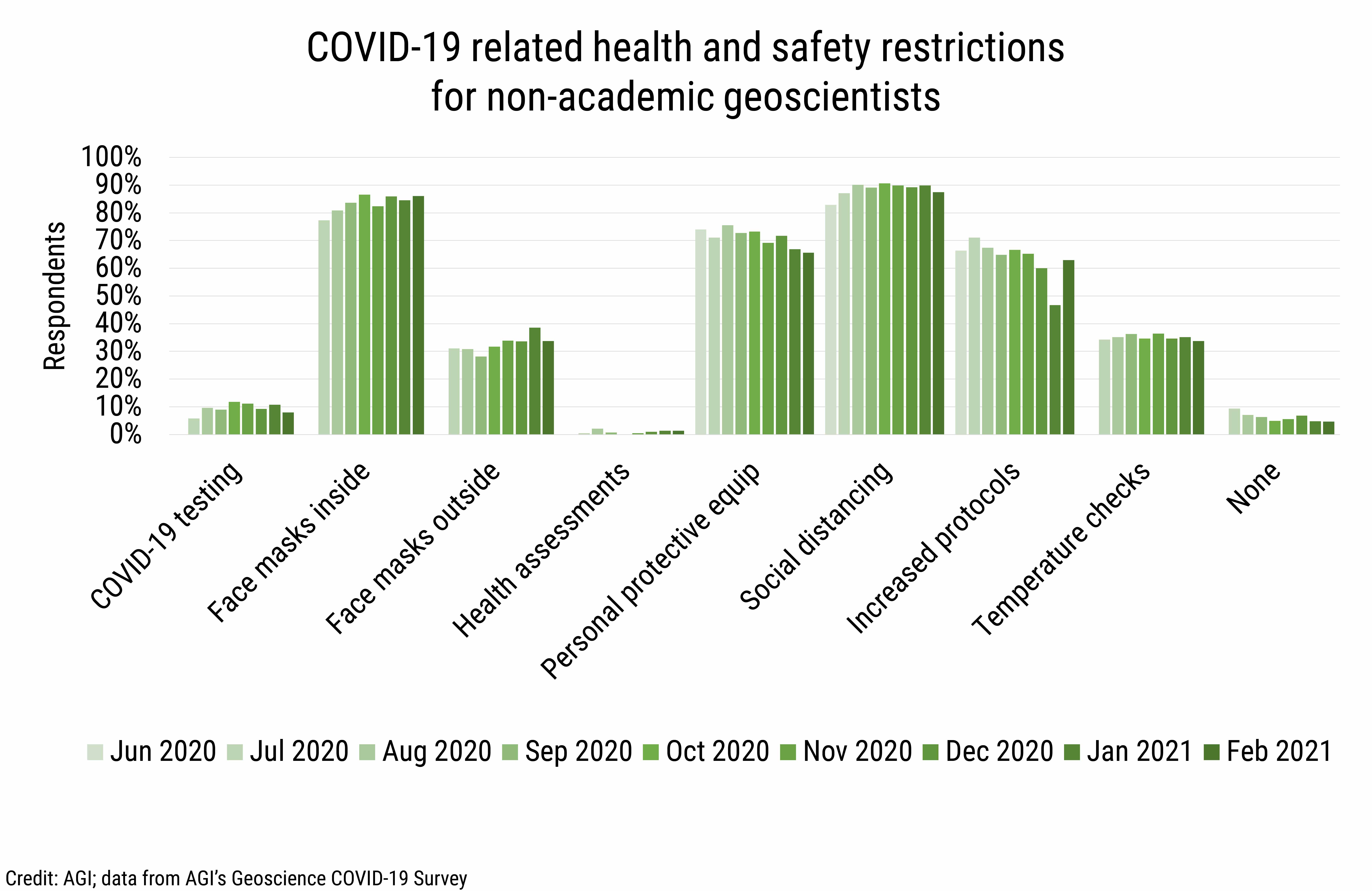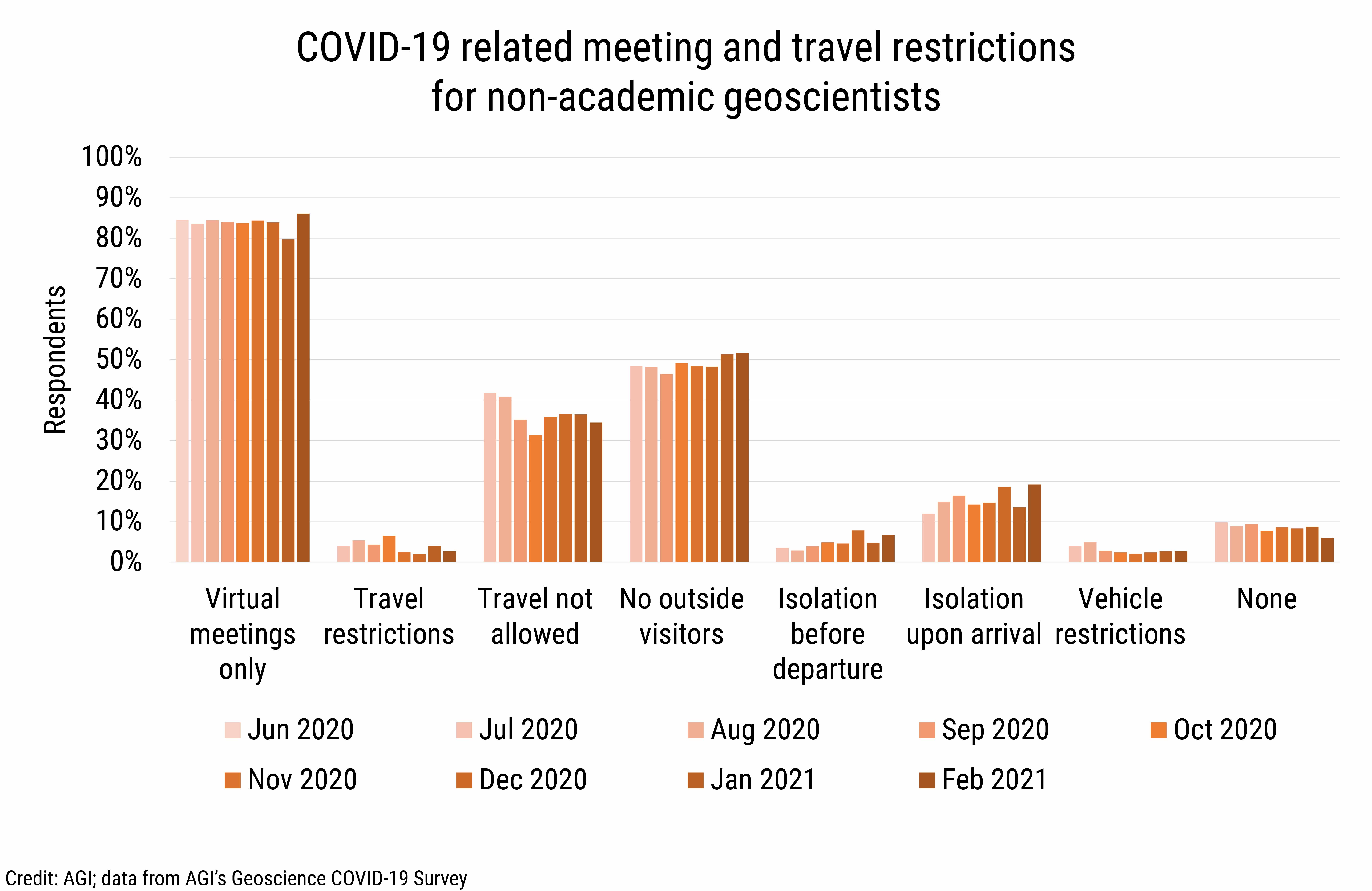Data Brief 2021-008 | March 26, 2021 | Written and compiled by Leila Gonzales and Christopher Keane, AGI
Download Data Brief
COVID-19 work and research activities and restrictions: Non-academic geoscientists
Literature review, writing and online research continue to be the
primary work and research mode for non-academic geoscientists. Fieldwork
and computational research activities were reported by 30% to 40% of
respondents since June 2020, with some declines in fieldwork activities
during late fall and winter. The percentage of respondents performing
lab-based activities increased from 12% to 22% between June 2020 and
February 2021.

DB_2021-008 chart 01: Work and research activities of non-academic geoscientists (Credit: AGI; data from AGI's Geoscience COVID-19 Survey)
AGI
Access restrictions and limited staffing at facilities continue to be
the most common COVID-19 related facility restriction reported by
non-academic geoscientists. Since June 2020, an increasing percentage of
respondents reported restrictions related to facility access, reduced
staffing at facilities, and deferral of lab activities. The percentage
of respondents reporting deferral of field activities has remained near
20%, with the exception of July and August 2020. The percentage of
respondents reporting no COVID-19 related facility restrictions
declined from 17% in July 2020 to 10% in February 2021.

DB_2021-008 chart 02: COVID-19 related facility restrictions for non-academic geoscientists (Credit: AGI; data from AGI's Geoscience COVID-19 Survey)
AGI
The use of face masks inside buildings and social distancing continues
to be the most common COVID-19 related health and safety protocols
reported by non-academic geoscientists. Since June 2020, an increasing
percentage of respondents have reported COVID-19 related health and
safety restrictions related to the use of face mask both indoors and
outdoors.
Since July 2020, the percentage of respondents reporting the use of
social distancing has remained near 90%, and the use of temperature
checks near 35%. The percentage of respondents reporting the use of
personal protective equipment has decreased from 74% in June 2020 to 66%
in February 2021, and the percentage of respondents reporting increased
health and safety protocols decreased slightly over the same period. The
percentage of respondents reporting no COVID-19 related health and
safety restrictions declined from 9% in July 2020 to 5% in February
2021.

DB_2021-008 chart 03: COVID-19 related health and safety restrictions for non-academic geoscientists (Credit: AGI; data from AGI's Geoscience COVID-19 Survey)
AGI
Virtual meetings continue to be the most common COVID-19 related meeting
and travel restriction reported by non-academic geoscientists. Since
June 2020, restrictions preventing travel have eased slightly, while
restrictions related to not allowing outside visitors into facilities
has edged up slightly. The percentage of respondents reporting isolation
policies before and after travelling increased from July 2020 to
February 2021 (4% to 7% and 12% to 19%, respectively). The percentage of
respondents reporting no COVID-19 related meeting and travel
restrictions declined from 10% in July 2020 to 6% in February 2021.

DB_2021-008 chart 04: COVID-19 related meeting and travel restrictions for non-academic geoscientists (Credit: AGI; data from AGI's Geoscience COVID-19 Survey)
AGI
Fifteen percent of non-academic geoscientists reported that there had
been a change to their work or research due to the pandemic. Of those
reporting changes to their work or research, most reported that the
change was limitations or cessation of in-person activities (i.e., lab
work, fieldwork, and other in-person activities) and a re-focusing of
efforts on tasks and projects that could be completed remotely, such as
project planning, training, online committee work, virtual outreach,
writing up research results, and conducting online research. Some
respondents mentioned shifting their focus to take care of routine tasks
that were usually performed during downtime, such as organizing and
maintenance of equipment and projects.
Just over one-fifth of non-academic geoscientists reported that the
pandemic had provided them the opportunity to explore new areas of work
or research. Comments included having the time to develop additional
technical skills, spending time conducting more in-depth research for
existing projects, pursuing new projects and employment opportunities,
and doing more virtual outreach, networking and collaboration.
Challenges related to work and research activities centered on the lack
of in-person interactions and informal discussions, difficulties with
collaborating and communicating with others, technology issues and
suboptimal work-from-home environments, COVID-related restrictions on
facility access, field activities, and travel. Other challenges included
decreased productivity and issues with work-life balance, less business
which impacted revenue and staffing, research impacts due to
restrictions and delays, project delays, and supply chain disruptions.
Respondents also commented on benefits to their new work and research
situation. Positives included the lack of needing to commute to the
office thus providing more time for research and writing as well as for
a better work-life balance. Respondents also commented on being allowed
to work remotely, which for some was a challenge during pre-pandemic
times when employers were less inclined to allow employees to work from
home. Respondents also commented on increased productivity, flexible
hours, lack of office politics, and less interruptions when working from
home as well as improved collaboration with colleagues. Other benefits
included the increased availability of online presentations and
activities which allowed for greater access to information and
professional development opportunities.
We will continue to provide current snapshots on the impacts of COVID-19
on the geoscience enterprise throughout the year. For more information,
and to participate in the study, please visit:
www.americangeosciences.org/workforce/covid19
Funding for this project is provided by the National Science Foundation
(Award #2029570). The results and interpretation of the survey are the
views of the American Geosciences Institute and not those of the
National Science Foundation.